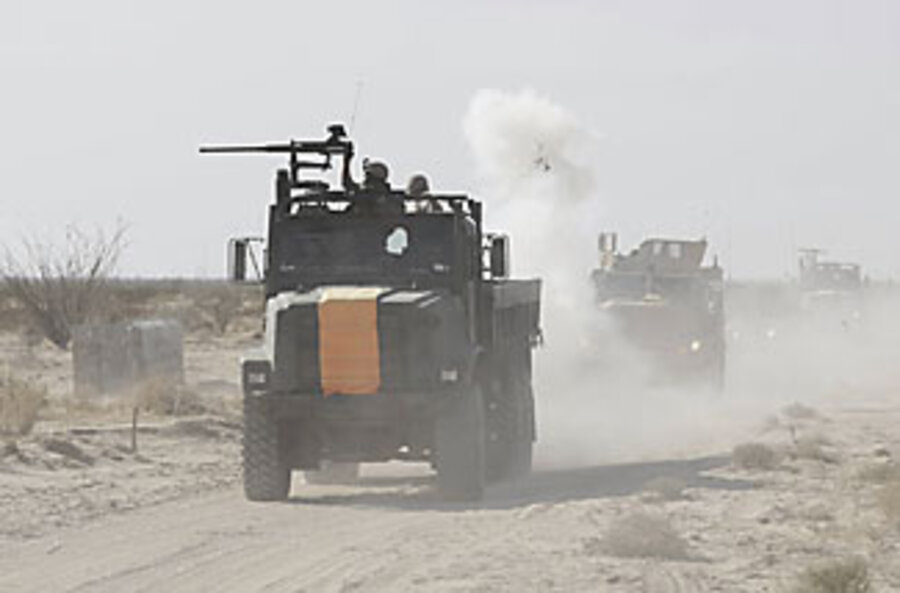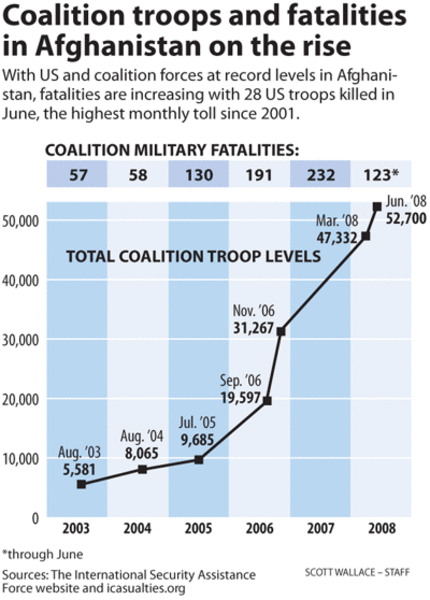Afghanistan death toll pressures U.S., allies
Loading...
| Washington
The rate of American fatalities in Afghanistan last month, the highest since US forces entered the country in 2001, is putting new pressure on the US and its allies to do more to counter insurgents there, but the pool of troops available to deploy is mostly dry.
US officials, including Defense Secretary Robert Gates, have signaled their desire to send more US troops to Afghanistan to fight a recently emboldened Taliban, more than six years after it was first defeated. But defense officials say the Pentagon is hamstrung by simple math: Mr. Gates can only send additional troops to Afghanistan when more are redeployed home from Iraq.
"I don't have troops I can reach for to send into Afghanistan until I have a reduced requirement in Iraq," said Adm. Mike Mullen, chairman of the Joint Chiefs of Staff in a Pentagon briefing Wednesday.
Admiral Mullen said there is no plan yet to accelerate new deployments to Afghanistan. These are still scheduled for "sometime in 2009," despite the improved situation in Iraq and emerging signs that violence in Afghanistan will continue to rise throughout the summer.
Last month, 28 American troops were killed in fighting in Afghanistan, the highest monthly number since 2001.
Maj. Gen. Jeffrey Schloesser, the top US commander in the country's eastern sector, says the violence is up 40 percent over last year in the US-led eastern sector of the country – still touted as a model of counterinsurgency work.
NATO officials point out, however, that most of the overall violence is still limited to under a dozen of the country's 365 districts.
Coalition commanders attribute the increase in violence to the warm season, which makes it easier for insurgents to fight, and to the increased efforts against the Taliban, Al Qaeda, and other "anti-coalition militias."
US officials have also expressed concern about insurgents staging attacks inside Afghanistan and then retreating to the border region in Pakistan, where the rules of engagement prevent coalition forces from entering.
The Pentagon last Friday issued a congressionally-mandated report on security and reconstruction in Afghanistan that portrayed a country still hobbled by insurgents' ability to create havoc. The report, the first of its kind and similar to one on Iraq issued quarterly for years, reflects the growing US focus on the war in Afghanistan.
"The Taliban regrouped after its fall from power and have coalesced into a resilient insurgency," the report said.
In addition to American casualties, 6,500 people died in 2007 as a result of suicide attacks, roadside bombs, and combat-related violence, the report added.
More than six years after the US declared victory over the Taliban in late 2001, the number of coalition fatalities have continued to climb, from 12 in 2001 to 232 last year, according to icasualties.org, which compiles casualty information. So far this year, there have been 123 coalition fatalities.
Since 2001, the US has had 541 fatalities, Great Britain 110, Canada 85, Germany 25, and the Netherlands 16, according to the website.
Combat operations in Afghanistan are led by NATO with a separate American force which makes up the largest contribution of any country deployed there.
As of June, there is a force of about 60,000 in Afghanistan, including about 33,000 Americans and 28,000 NATO forces from as many as 40 countries.
Analysts and defense officials believe more forces would help quell the violence. A deployment of about 3,300 Marine trainers and combat forces were sent there this spring. More are needed, analysts say, but the US's ability to send more rests on its ability to withdraw troops from Iraq.
This month, the US is withdrawing from Iraq the last of its five "surge brigades" that have been credited in part with the increased security situation there.
Gen. David Petraeus, the top US commander in Iraq, said earlier this year that he would recommend reducing American forces in Iraq beyond that sometime by fall. In testimony in Washington in May, General Petraeus was vague about the size of the additional withdrawal, but left open the possibility that it could be another brigade, a force of roughly 3,500 people.
Senior Pentagon officials have said privately they believe they could deploy another brigade to Afghanistan even without the additional withdrawal from Iraq – if one more brigade was allowed to return home from Iraq, that would free up enough soldiers to send a new unit into Afghanistan.
Mullen has said his first priority for sending forces to Afghanistan is to send trainers to help train and equip the fledgling Afghan National Army and police.






